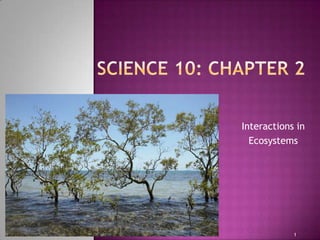
Chapter 2 Slides
- 1. Interactions in Ecosystems 1
- 2. Bioticfactors = living things (plants, animals, bacteria, fungi, protists) 2
- 3. Abiotic factors = non-living things (air, water, soil, temperature, precipitation, l ight, etc..) 3
- 4. Biosphere contains Biomes Biomes contain Ecosystems Ecosystems contain Habitats where a variety of organisms live 4
- 5. Ecosystem = a part of a biome in which biotic and abiotic components interact Can be small tide pools, rotting log Can be large entire forest Biotic components depend on Abiotic components 5
- 6. ORGANISM Individual member of a species POPULATION all of the members of a certain species within an ecosystem 6
- 7. COMMUNITY all the organisms that interact within an ecosystem All of the biotic factors! ECOSYSTEM part of a biome in which biotic AND abiotic components interact 7
- 8. Organism Population Community Ecosystem 8
- 9. Page 24: Questions 1-7 Chapter 2 Review Questions Chapter 2 Vocabulary 9
- 10. Producers (autotrophs) 10
- 11. Carnivores Omnivores Detrivores Herbivores 11
- 12. Relationshipbetween the “eaters” and the “eaten” Predators have adaptations to help them catch prey Prey have adaptations to avoid predators Spines, shells, camouflage, mi micry 12
- 13. Predator-prey cycle If numbers of prey increase, then numbers of predators increase (more food), which then causes numbers of prey to decrease… and so on 13
- 14. Page 29: Questions 1-13 Chapter 2 Review Questions Chapter 2 Vocabulary 14
- 15. Symbiotic relationships = interactions between members of two different species Parasitism meh. Mutualism Commensalism 15
- 16. Both species benefit Biological example: bees and flowers 16
- 17. One species benefits, the other is harmed Biological example: hookworm in dogs 17
- 18. One species benefits, one is not affected Biological example: barnacles on a whale meh. 18
- 19. Page 32: Questions 1-11 Chapter 2 Review Questions Chapter 2 Vocabulary 19
- 20. Energy flow = transfer of energy from one organism to another in an ecosystem Energy moves in only ONE direction in an ecosystem ARROWS used to show direction of energy flow Energy is LOST as it moves from one organism to another Original source of energy is the SUN 20
- 21. TROPHIC LEVEL = position of an organism within a food chain Trophic levels: PRODUCERS produce carbohydrates from CO2, water and energy from the sun CONSUMERS get energy by eating producers and/or other consumers 21
- 22. 22
- 23. Most consumers eat more than one type of food and so a web represents a more realistic view of what they eat. Arrows point TOWARDS consumers 23
- 24. 90% energy loss at each trophic level Less energy reaches higher trophic levels Fewer organisms at higher trophic levels 24
- 25. Page 37: Questions 1-11 Page 41: Questions 1-7, 9 & 11 Chapter 2 Review Questions Chapter 2 Vocabulary 25